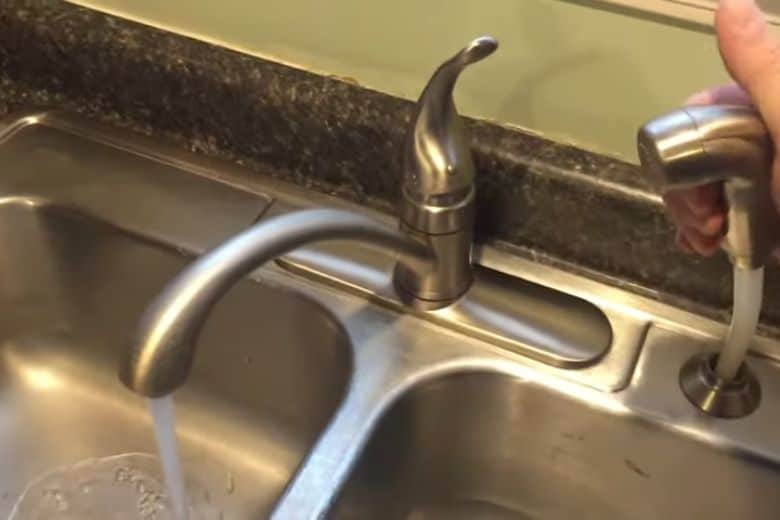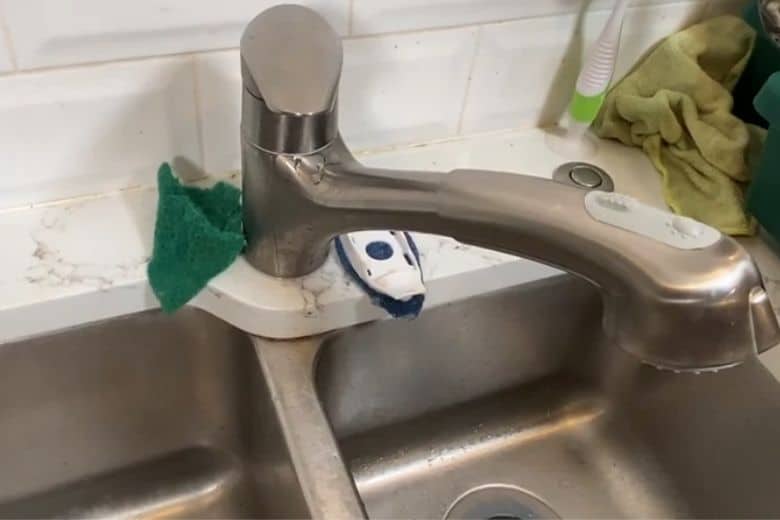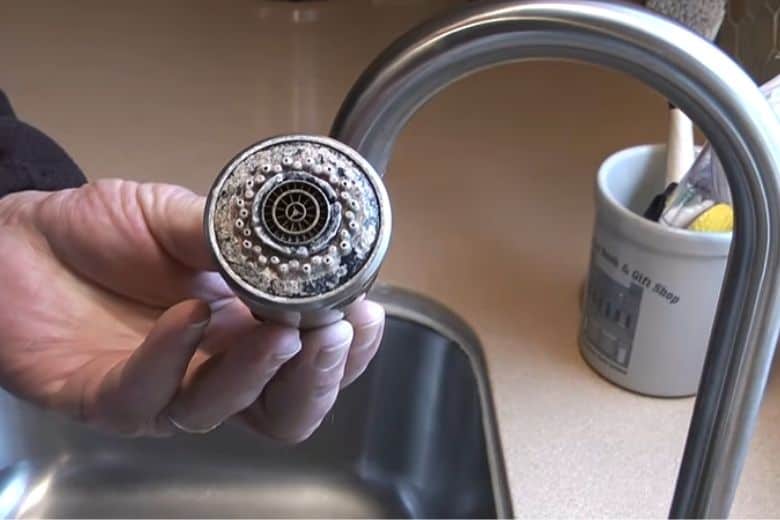The diverter in the kitchen faucet is responsible for diverting the water flow. It diverts the water from the sprout to the sprayer. Also, it works to control the water flow for different spray functions. So, when you see a kitchen faucet not diverting between spray functions, it is worrisome.
Usually, the diverter will stop working in between the spray modes due to a clogged valve. You must remove the diverter valve and clean and reinstall it to help the faucet work properly. Also, residual build-up in the faucet aerator and leaks in the spray head and hose are common problems with kitchen faucets. We will answer their solutions too.
Signs Of Kitchen Faucet Not Diverting Between Spray Functions:
The diverter will transfer the water in the correct spray mode typically. As it fails, the spray modes will not work correctly. You can identify these issues through quick observations.
- You will simultaneously experience multiple spray functions. It happens because the diverter fails to transfer the water flow to the preferred spray mode.
- Alternatively, the spray head might not work correctly. So, the spray head won’t switch in various sprayer functions.
- The spray head has a button. It might fall off from the spray head and stop the diverter.
As you inspect the signs, you must understand why it happens.
Reasons of kitchen faucet stuck on spray mode:
Did the kitchen faucet stop working and refuse to divert between sprayer modes? It can be for many reasons.
- The spray button on the spray head may need to be updated and has worn out. The spray head usually lasts for 5 to 7 years. As it gets older, it can accumulate dirt and debris. The residual development and friction of the diverter will cause wear and tear. Thus, it will stop working.
- The button on the kitchen faucet sprayer head might go missing. As it happens, the diverter won’t work anymore to allow the sprayer functions to work correctly.
- Lastly, the water diverter inside the faucet may develop residues. As it happens, the diverter will get stuck. So, you need to unclog it. Thus, it will allow the diverter to transfer the water at different spray modes.
Solutions to kitchen sink sprayer stuck on
When the sink sprayer in the kitchen gets stuck in, it can be indeed frustrating. Thankfully, you now know why the kitchen sink faucet diverter gets stuck. So, it’s time to troubleshoot it.
Solution 1: Replace the worn-out spray head
The pull-out and pull-in sink faucets have spray heads. The diverter works in tandem with it. As the spray head gets old and wears out, you should replace them.
- First, identify the model number of the kitchen sink faucet. Then, you can quickly find the part number of the sprayer head of the faucet.
- If you find it difficult, you can take a photograph of the faucet and its sprayer head. Then, take the photographs to a plumber or hardware store. You can now find the right spryer head for your faucet.
- Once you have purchased the sprayer head, you need to replace the old one. First, pry off the cap from the kitchen faucet. Then, remove the screws to access the spray head inside.
- You can remove the spray head with a screwdriver by untightening the nuts and bolts. After that, mount the new sprayer head quickly.
Solution 2: Releasing the stuck spray button
The spray button might stop moving for residual development. As the kitchen sink sprayer stuck on happens, you need to unclog it. Otherwise, the stuck sprayer button won’t release, and the spray modes will not work.
Start by observing the stuck spray button. Is there any residue around it? You can remove the residue from the exterior of the button with a toothpick. If the debris has gotten inside, you must remove the sprayer head. Then, use vinegar and baking soda to unclog the stuck spray button. Soaking it overnight in the solution should fix the problem.
Solution 3: Unclogging the diverter valve
Mostly, the diverter valve inside the kitchen sink pull-out faucet gets clogged to stop working. Over time, residue and sediment may develop around the diverter. When you last cleaned the faucet sink diverter for years, the sediment build-up will clog it.
Thus, the clogged diverter valve gets stuck between spray functions. The quick solution is to clean the diverter to unclog it. You may follow our suggested stops for it:
- First, switch off the kitchen faucet water valves. It will stop the faucet and hose from overflowing as you work with the diverter valves.
- Use a flathead screwdriver to remove the screws holding the faucet water handle. It lets you access the diverter valve afterward.
- Once you have removed the screws, try turning the faucet cap in an anticlockwise direction. This way, you can quickly remove the faucet handle.
- It will expose the cam inside the handle. Then, you may find the faucet ball by removing the cam inside. After that, you must also remove the faucet ball.
- Start moving the water spout back and forth. As it loosens up, you can remove the water spout with ease. It allows you to look at the faucet stem where the diverter valve sits.
- You can quickly pry off the diverter valve. Afterward, you should prepare a solution of baking soda and vinegar to soak the diverter overnight. It will unclog the diverter and help it properly work at different spray functions.
Apart from these problems and solutions, there can be other issues too. So, when you see the kitchen faucet sprayer not working, check its aerator too. Often, the aerator gets clogged due to hardwater and stops working. Then, there will be no water at all. Also, low water pressure in the sink faucet might happen for residual development. Then, the spray hose may leak so it won’t provide adequate water.
Frequently Asked Questions:
How do you fix a spray diverter?
Answer: Fixing a spray diverter depends on the problem. If it gets stuck, you need to unclog it. Hence, remove it from the faucet stem and soak it in white vinegar. If it has worn out, you should replace the older one. Thus, it is crucial to consider the reasons for a malfunctioning spray diverter and seek the correct troubleshooting accordingly.
Why do diverter valves fail?
Answer: A kitchen sink faucet diverter valve fails mainly due to sediment and residue development. It stops the diverter valve from moving freely. Therefore, you will need help transforming between various sprayer modes. With the diverter valve failure, it is frustrating as you can’t clean the dishes and kitchen utensils anymore.
What is the difference between a diverter and a valve?
Answer: The water valve and sink faucet diverter differ in their water supply system. A valve will usually control the water flow in various outlets. On the contrary, the diverter transfers the water between the spout and the sprayer. Also, showers and tubs divert the water from the showerhead to the bathtub faucet.
How many types of diverters are there?
Answer: You will find three types of kitchen and bathroom sink faucet diverters. These are a 3-inlet, hi-flow, and standard sink faucet diverter. Firstly, the conventional diverter is preferable for its easy operation. On the contrary, a 3-inlet diverter will provide you with fresh, hot, and cold water separately. Hence, it provides you with the best services.
Conclusion
At the end of our elaborate discussion, you surely understand why kitchen faucet not diverting between spray functions. Therefore, you have also got adequate solutions to the problem. However, if you find anything difficult to understand, don’t hesitate to comment below, and we will answer your query as soon as possible.
Paul Newman is a blogger who writes about plumbing and home improvement. Over the past 20 years, I have worked as a plumber. My passion is to share my knowledge and experience with others to improve their homes.





I have a kitchen faucet problem either the faucet works or the sprayer but not both,what could be the problem?
The issue you are facing mainly occurs from the diverter valve problem in the faucet. It is what directs water from the faucet to the sprayer. If you can, inspect it, and find out if it got damaged or worn out. If it is damaged, it may not allow the faucet and sprayer to work simultaneously. It may need to clean, repair, or replace.